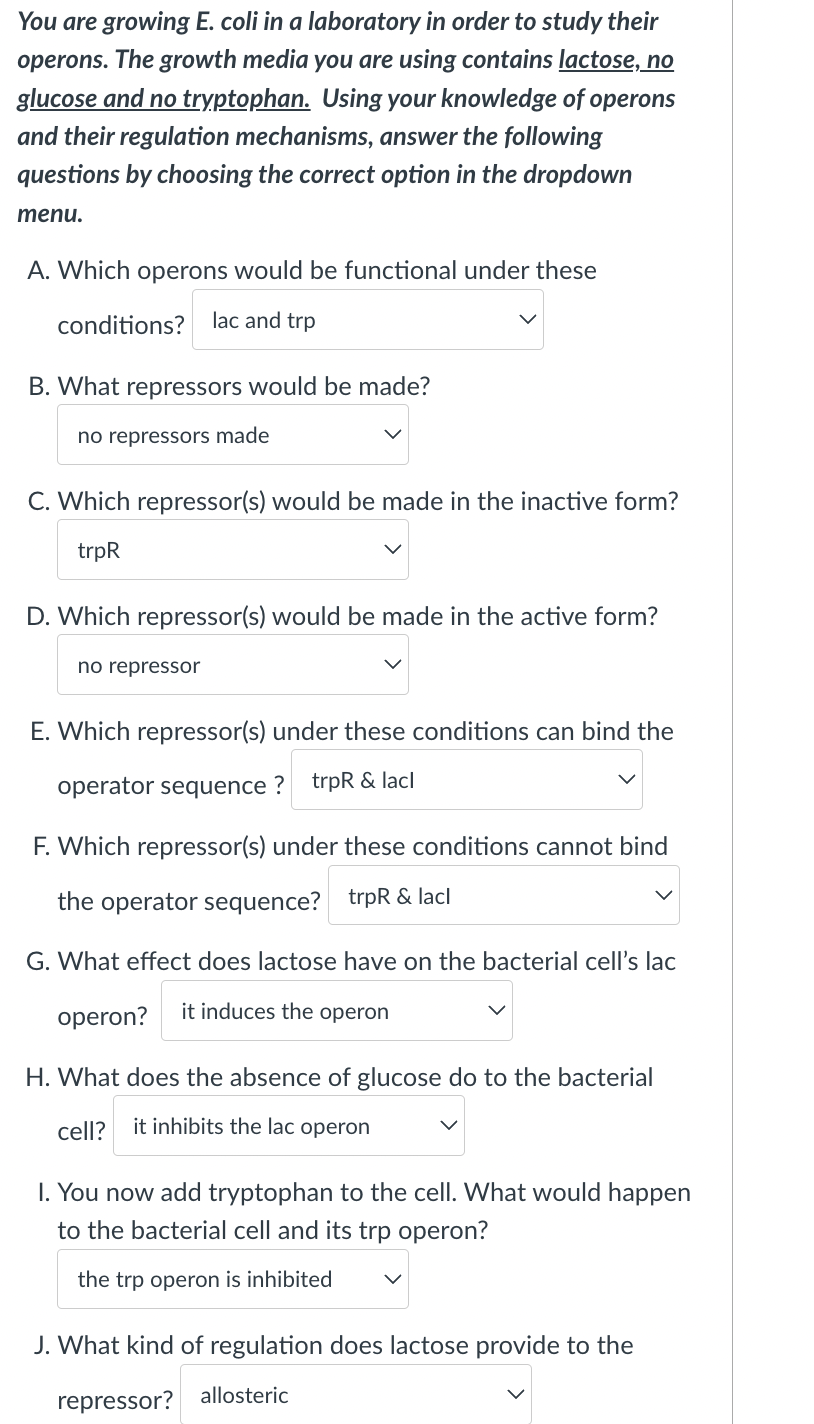A. Which operons would be functional under these conditions? lac and trp B. What repressors would be made? no repressors made C. Which repressor(s) would be made in the inactive form? trpR D. Which repressor(s) would be made in the active form? no repressor E. Which repressor(s) under these conditions can bind the operator sequence ? trpR & lacl F. Which repressor(s) under these conditions cannot bind the operator sequence? trpR & lacl G. What effect does lactose have on the bacterial cell's lac operon? it induces the operon H. What does the absence of glucose do to the bacterial cell? it inhibits the lac operon I. You now add tryptophan to the cell. What would happen to the bacterial cell and its trp operon? the trp operon is inhibited J. What kind of regulation does lactose provide to the repressor? allosteric
A. Which operons would be functional under these conditions? lac and trp B. What repressors would be made? no repressors made C. Which repressor(s) would be made in the inactive form? trpR D. Which repressor(s) would be made in the active form? no repressor E. Which repressor(s) under these conditions can bind the operator sequence ? trpR & lacl F. Which repressor(s) under these conditions cannot bind the operator sequence? trpR & lacl G. What effect does lactose have on the bacterial cell's lac operon? it induces the operon H. What does the absence of glucose do to the bacterial cell? it inhibits the lac operon I. You now add tryptophan to the cell. What would happen to the bacterial cell and its trp operon? the trp operon is inhibited J. What kind of regulation does lactose provide to the repressor? allosteric
Biology (MindTap Course List)
11th Edition
ISBN:9781337392938
Author:Eldra Solomon, Charles Martin, Diana W. Martin, Linda R. Berg
Publisher:Eldra Solomon, Charles Martin, Diana W. Martin, Linda R. Berg
Chapter14: Gene Regulation
Section: Chapter Questions
Problem 9TYU: A mutation that inactivates the repressor gene of the lac operon results in (a) the continuous...
Related questions
Question
are my answer correct or wrong please correct me for the right answers

Transcribed Image Text:You are growing E. coli in a laboratory in order to study their
operons. The growth media you are using contains lactose, no
glucose and no tryptophan. Using your knowledge of operons
and their regulation mechanisms, answer the following
questions by choosing the correct option in the dropdown
menu.
A. Which operons would be functional under these
conditions?
lac and trp
B. What repressors would be made?
no repressors made
C. Which repressor(s) would be made in the inactive form?
trpR
D. Which repressor(s) would be made in the active form?
no repressor
E. Which repressor(s) under these conditions can bind the
operator sequence ?
trpR & lacl
F. Which repressor(s) under these conditions cannot bind
the operator sequence? trpR & lacl
G. What effect does lactose have on the bacterial cell's lac
operon?
it induces the operon
H. What does the absence of glucose do to the bacterial
cell? it inhibits the lac operon
I. You now add tryptophan to the cell. What would happen
to the bacterial cell and its trp operon?
the trp operon is inhibited
J. What kind of regulation does lactose provide to the
repressor? allosteric
Expert Solution
This question has been solved!
Explore an expertly crafted, step-by-step solution for a thorough understanding of key concepts.
Step by step
Solved in 2 steps

Knowledge Booster
Learn more about
Need a deep-dive on the concept behind this application? Look no further. Learn more about this topic, biology and related others by exploring similar questions and additional content below.Recommended textbooks for you

Biology (MindTap Course List)
Biology
ISBN:
9781337392938
Author:
Eldra Solomon, Charles Martin, Diana W. Martin, Linda R. Berg
Publisher:
Cengage Learning

Biology (MindTap Course List)
Biology
ISBN:
9781337392938
Author:
Eldra Solomon, Charles Martin, Diana W. Martin, Linda R. Berg
Publisher:
Cengage Learning